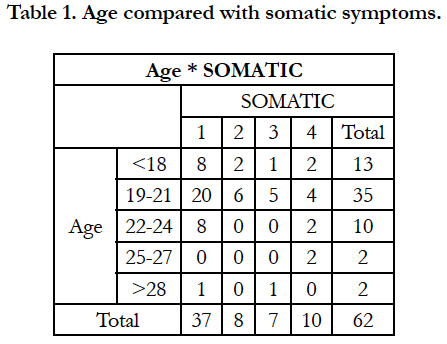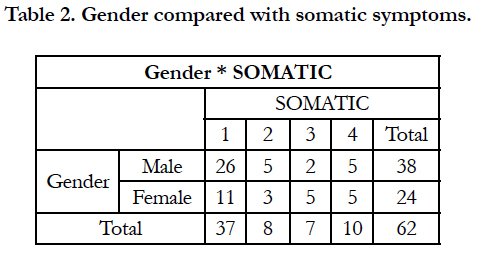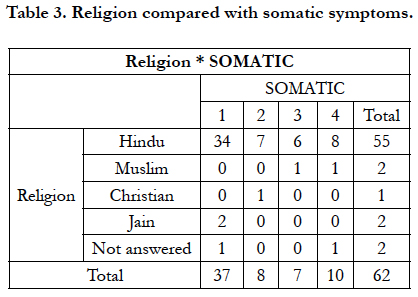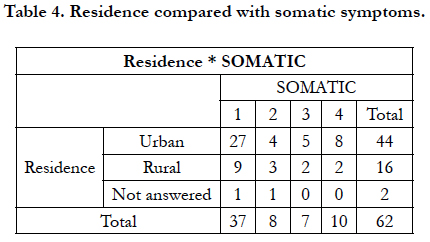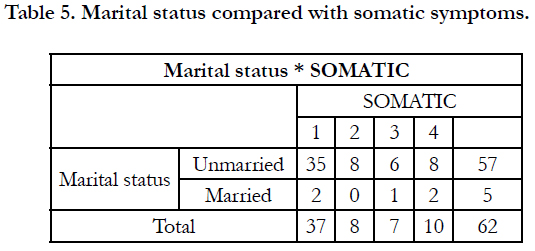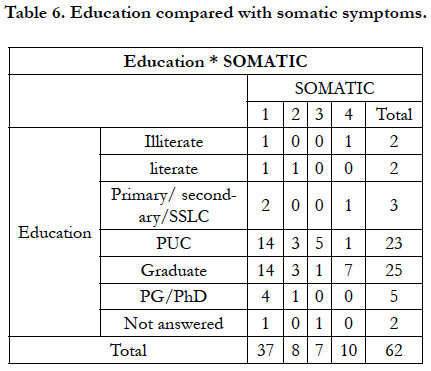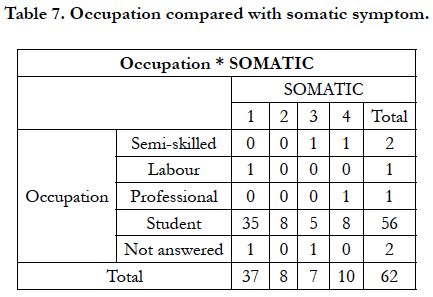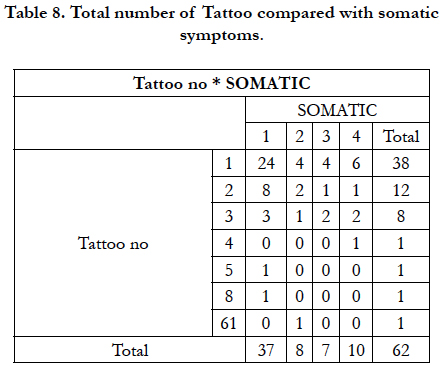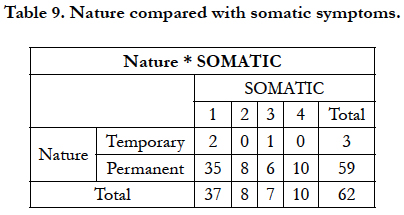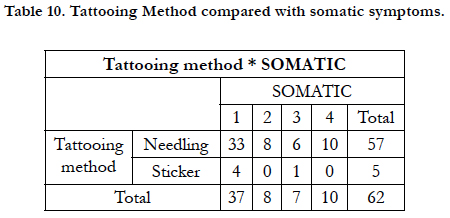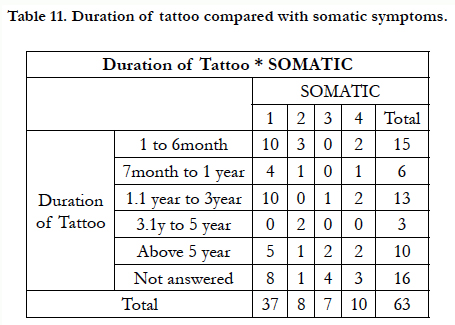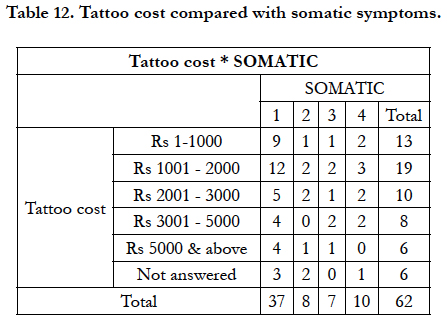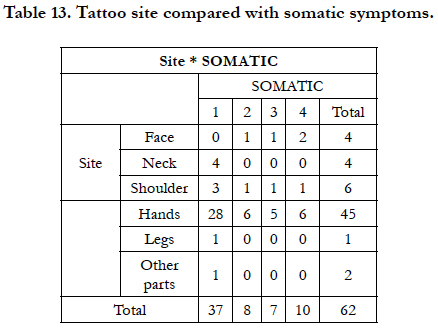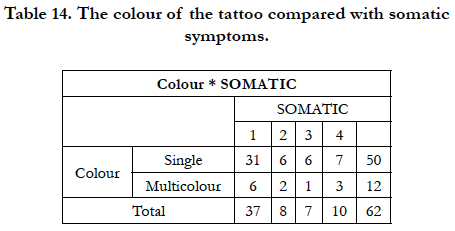Anthropological Study of Somatic Symptoms in Tattooed Individuals
Anitha MR1, Vijayanath V2*
1 Professor & Head of the Department, Department of Anatomy, Akash Institute of Medical Sciences & Research Centre, Devanhalli, Bengaluru, Karnataka, India.
2 Professor & Head of the Department, Department of Forensic Medicine, ESIC Medical College & PGIMSR, Rajajinagar, Bengaluru, Karnataka, India.
*Corresponding Author
Dr. Vijayanath V,
Professor & Head of the Department, Department of Forensic Medicine,
ESIC Medical College & PGIMSR, Rajajinagar, Bengaluru, Karnataka, India.
Tel: +91-9986616961
E-mail: drvijayanath@rediffmail.com
Received: April 04, 2019; Accepted: April 29, 2019; Published: May 13, 2019
Citation: Anitha MR, Vijayanath V. Anthropological Study of Somatic Symptoms in Tattooed Individuals. Int J Anat Appl Physiol. 2019;5(2):111-114. doi: dx.doi.org/10.19070/2572-7451-1900020
Copyright: Vijayanath V©2019. This is an open-access article distributed under the terms of the Creative Commons Attribution License, which permits unrestricted use, distribution and reproduction in any medium, provided the original author and source are credited.
Abstract
Introduction: Tattoo is expected to alter the new wearer's perception of the individual's identity. For the same reason, tattoos seem to have the ability to have a greater impact on one's self, with minimal variations and majority potentially affected identity.
Aims: Examine the tattoos along with the level of somatic symptoms with life's various dimensions.
Methodology: The study was conducted in the student community studying in professional colleges. The study was conducted between January 2018 to June 2018. The tool used to measure the somatic symptoms were based on the Patient Health Questionnaire (PHQ)scale. PHQ-15 Somatic Symptom Severity.
Results: The somatic symptoms scores are given as follows; 1=0-5, 2=6-10, 3=11-15, 4=>21. Scores of 5, 10, and 15 represent cut points for mild, moderate, and severe anxiety, respectively.
Discussion: Our study included more of age group 19-21 having got this tattoo done on them, and suffering from severe somatic symptoms. Majority of the women will be obtaining the tattoos only after 30 years of age and also inclined to have more severe somatic symptoms. Majority of the cases for the said study were from Hindu only and were suffering from overall somatic symptoms. In our study, the majority of the subjects had only one tattoo. Hands were the prominent parts of the body in which the tattoo is being obtained. Colours used in the tattoo are of single coloured as compared to multicoloured.
Conclusion: Males, Unmarried were more in number with Hindu & Urban predominance with somatic symptoms diagnosis. And a higher number of the individuals had obtained the tattoo in hands, which probably indicates exhibitionism of tattoo.
2.Abbreviations
3.Introduction
4.Methodology
5.Results
6.Discussion
7.Conclusion
8.References
Keywords
Tattoo; Somatic; Assessment.
Abbreviations
PHQ: Patient Health Questionnaire.
Introduction
Tattoos are increasing in size and popularity around the world, especially in the younger generation. Traditionally it is commonly seen in most of the religions having these tattoos; more common in females. Inserting tattoo, into the skin by introducing them through punctures has long posed an intriguing problem; commonly seen as challenging medical practice. The tattoo is expected to alter the new wearer's perception of the individual's identity. For the same reason, tattoos seem to have the ability to have a greater impact on one's self, with minimal variations and majority potentially affected identity.
In the recent era, tattoos are even recognized as having autotherapeutical power which is in case of psychological trauma [1]. Tattoo and Body modifications are also considered a healthier alternative to attempts of self-mutilation [2].
Tattooing is more common among the younger generation. It is even conceptualized that tattooing is an alternative form of expression when one is unable to verbalize through language. It has also been said in the general population that tattooing reflects pain tolerance and physical endurance, as a means of emphasizing sexuality. Tattooing is also considered inherently painful which is voluntary with a common history of self-injury and suicidal ideation. There are numerous works are being conducted with regard to tattoo and mental health. In the majority of the available literature research, it has been mentioned that positive correlation between tattooing and risk-taking behaviours [3]. and because of this risk-taking behavior it has been believed that tattoo may be used as marker for mortality due to suicide [4]. It is also not completely correct to mention that all the tattooed individuals are having one or the other psychopathology. It is an individual’s desire to maintain the uniqueness/self-identity by getting such tattoos done on their body [5]. It is essential to understand the possible reasons with respect to somatic symptoms being the initiating or triggering factor for getting the tattoo done.
Aim: Examine the tattoos along with the level of somatic symptoms with life's various dimensions.
Methodology
The study was conducted in the student community studying in professional colleges. The study was conducted between January 2018 to June 2018. The study group included only the volunteer willing to participate in the study. Those students who had a tattoo by the virtue of religion or custom and have not consented have been excluded.
The tool used to measure the somatic symptoms were based on the Patient Health Questionnaire (PHQ) scale [6]. PHQ-15 Somatic Symptom Severity. This is calculated by assigning scores of 0, 1, and 2 to the response categories of -not at all, -bothered a little, and -bothered a lot, for the 13 somatic symptoms of the PHQ.
Results
The somatic symptoms scores are given as follows; 1=0-5, 2=6-10, 3=11-15, 4=>21.
Scores of 5, 10, and 15 represent cut points for mild, moderate, and severe anxiety, respectively.
The somatic symptoms scores are given as follows; 1=0-5, 2=6-10, 3=11-15, 4=>21.
The somatic symptoms scores are given as follows; 1=0-5, 2=6-10, 3=11-15, 4=>21
Scores of 5, 10, and 15 represent cut points for mild, moderate, and severe anxiety, respectively
The somatic symptoms scores are given as follows; 1=0-5, 2=6-10, 3=11-15, 4=>21
Scores of 5, 10, and 15 represent cut points for mild, moderate, and severe anxiety, respectively.
The somatic symptoms scores are given as follows; 1=0-5, 2=6-10, 3=11-15, 4=>21
Scores of 5, 10, and 15 represent cut points for mild, moderate, and severe anxiety, respectively
The somatic symptoms scores are given as follows; 1=0-5, 2=6-10, 3=11-15, 4=>21
Scores of 5, 10, and 15 represent cut points for mild, moderate, and severe anxiety, respectively
The somatic symptoms scores are given as follows; 1=0-5, 2=6-10, 3=11-15, 4=>21
Scores of 5, 10, and 15 represent cut points for mild, moderate, and severe anxiety, respectively
The somatic symptoms scores are given as follows; 1=0-5, 2=6-10, 3=11-15, 4=>21
Scores of 5, 10, and 15 represent cut points for mild, moderate, and severe anxiety, respectively
Discussion
As depicted in the results as the sampling method most of the subjects in the study were of the younger generation. Even though the sampling size is not including the older age groups; the earlier studies have indicated that the tattooing is very common in the younger generation. And our study included more of age group 19-21 having got this tattoo done on them. These group individuals also exhibited more somatic symptoms compared to other groups. Twenty were suffering from mild somatic symptoms, whereas 4 were suffering from severe somatic symptoms which can be categorized as an anxiety disorder. It also shows male predominance which is in favour of the study done by Laumann [7]. In Laumann’s study it has been noted that majority of the women will be obtaining the tattoos only after 30 years of age. With respect to gender both the groups were showing the same number of severe somatic symptoms; even though the males were more in the study group. If it is been compared with percentage the female will have the upper hand in severe somatic symptoms.
When it is compared to religion; since this part of the country is highly dense with Hindu population, the majority of the cases for the said study were from Hindu only. Among these Hindu subjects, 8 individuals had severe somatic symptoms. And the same reason goes in favour of residence of the individual, this could be one of the reason that majority of the students studying in this part of the city were from urban backup; at the same time, fastgrowing urbanization cannot be ruled out. Eight urban subjects exhibited severe somatic symptoms. The same theory for marital status, education, and occupation status hold good. and 8 subjects who were unmarried also expressed the sever somatic symptoms.
In our study majority of the subjects had only one tattoo which is inconsistent with a study conducted in Brazilian military recruits which revealed that 66% of the individuals had a single tattoo and 21% had two tattoos [8]. and 8 student subjects were suffering from severe somatic symptoms. The subjects also mentioned the high level of satisfaction with their first tattoo, tended to have the second or third tattoo after their first tattoo as a favourite. Similar studies have been not found in the literature search regarding the nature of tattoo; either it is temporary or permanent. And also the method of tattooing either by needle or sticker was not mentioned in the available literature.
Moreover, the study subjects in this study were in the duration of about 1 month to 1 year and less than 3 years after obtaining the tattoo. Regarding the duration of the tattoo being done in earlier studies had included only tattoos of permanent in nature and time since it is being obtained has not been mentioned. Study subjects have spent around rupees 2000/- on average. Cost of the tattooing is again a factor which is not comparable with available literature.
Hands were the prominent parts of the body in which the tattoo is being obtained. This finding also does not have literature support but it appears to be with the possible reasons that, hands are the exposed parts which are easily noticeable and identified for all the purposes. Colours used in the tattoo are of single coloured as compared to multi-coloured.
Conclusion
The study is undertaken mainly to identify the somatic symptoms in the tattooed individual. As the study is being conducted in the professional college students so the majority are in the younger age group. And somatic symptoms were measured with the help of PHQ (Patient Health Questionnaire). Males, Unmarried were more in number with Hindu & Urban predominance. And a higher number of the individuals had obtained the tattoo in hands.
References
- Sarnecki JH. Trauma and tattoo. Anthropol Conscious. 2001 Sep 1;12(2):35-42.
- Kasten E. Body Modification. Psychological and medical aspects of piercing, tattoo, self-injury and other body changes. Munich: Reinhardt Of 2006.
- Stirn A, Hinz A, Brähler E. Prevalence of tattooing and body piercing in Germany and perception of health, mental disorders, and sensation seeking among tattooed and body-pierced individuals. J Psychosom Res. 2006 May;60(5):531-4. PubMed PMID: 16650594.
- Dhossche D, Snell KS, Larder S. A case-control study of tattoos in young suicide victims as a possible marker of risk. J Affect Disord. 2000 Aug;59(2):165-8. PubMed PMID: 10837885.
- Wohlrab S, Stahl J, Kappeler PM. Modifying the body: Motivations for getting tattooed and pierced. Body Image. 2007 Mar;4(1):87-95. PubMed PMID: 18089255.
- Kroenke K, Spitzer RL, Williams JB. The PHQ-15: validity of a new measure for evaluating the severity of somatic symptoms. Psychosom Med. 2002 Mar-Apr;64(2):258-66. PubMed PMID: 11914441.
- Laumann AE, Derick AJ. Tattoos and body piercings in the United States: a national data set. J Am Acad Dermatol. 2006 Sep;55(3):413-21. PubMed PMID: 16908345.
- Bicca JF, Duquia RP, Breunig JD, Souza PR, Almeida Jr HL. Tattoos on 18-year-old male adolescents-Characteristics and associated factors. An Bras Dermatol. 2013 Nov-Dec;88(6):925-8. doi: 10.1590/abd1806-4841.20132192. PubMed PMID: 24474101.

